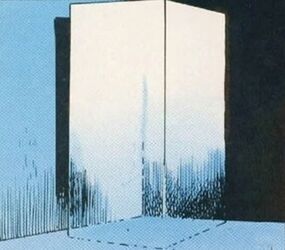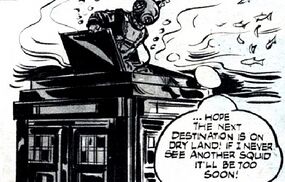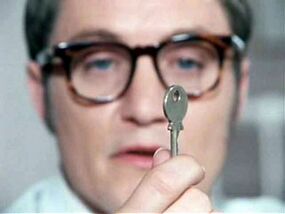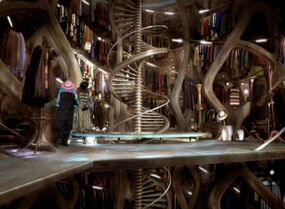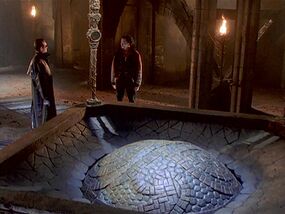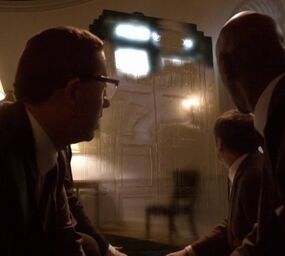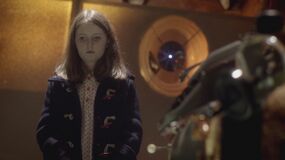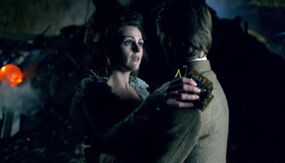The Doctor's TARDIS: Difference between revisions
m (getting rid of bulleting in infobox) |
Bold Clone (talk | contribs) mNo edit summary |
||
| Line 2: | Line 2: | ||
|image = DoctorsTARDIS.png | |image = DoctorsTARDIS.png | ||
|object name = The Doctor's TARDIS | |object name = The Doctor's TARDIS | ||
|type = [[Type 40]] [[TARDIS]]<!--Please do not insert the term "Mark 1" or "Mark 3" here. | |type = [[Type 40]] [[TARDIS]]<!--Please do not insert the term "Mark 1" or "Mark 3" here. There's no question of it being a Type 40; but obviously Let's Kill Hitler and The Time Meddler directly contradict each other. Keep the controversy outta the infobox, please.--> | ||
|origin = [[Time Lord]]s | |origin = [[Time Lord]]s | ||
|appearances = [[DW]]: All ''[[Doctor Who]]'' TV stories apart from ''[[Mission to the Unknown]]'', ''[[Doctor Who and the Silurians]]'', ''[[The Sea Devils]]'', ''[[The Sontaran Experiment]]'', ''[[Genesis of the Daleks]]'', ''[[Midnight (TV story)|Midnight]]'' and ''[[Up All Night]]''<br />[[TW]]: ''[[End of Days]]'' (materialisation sound only)<br />[[SJA]]: ''[[Secrets of the Stars]]'' (flashback)<br />[[SJA]]: ''[[The Mad Woman in the Attic]]'' (cameo)<br />[[SJA]]: ''[[The Wedding of Sarah Jane Smith]]''<br />[[SJA]]: ''[[Death of the Doctor]]''<br />[[WC]]: ''[[Prequel (Let's Kill Hitler)]]''<br /> | |appearances = [[DW]]: All ''[[Doctor Who]]'' TV stories apart from ''[[Mission to the Unknown]]'', ''[[Doctor Who and the Silurians]]'', ''[[The Sea Devils]]'', ''[[The Sontaran Experiment]]'', ''[[Genesis of the Daleks]]'', ''[[Midnight (TV story)|Midnight]]'' and ''[[Up All Night]]''<br />[[TW]]: ''[[End of Days]]'' (materialisation sound only)<br />[[SJA]]: ''[[Secrets of the Stars]]'' (flashback)<br />[[SJA]]: ''[[The Mad Woman in the Attic]]'' (cameo)<br />[[SJA]]: ''[[The Wedding of Sarah Jane Smith]]''<br />[[SJA]]: ''[[Death of the Doctor]]''<br />[[WC]]: ''[[Prequel (Let's Kill Hitler)]]''<br /> | ||
|mentions = [[DW]]: ''[[Genesis of the Daleks]]''<br />[[DW]]: ''[[Midnight (TV story)|Midnight]]''<br />[[SJA]]: ''[[The Empty Planet]]'' | |mentions = [[DW]]: ''[[Genesis of the Daleks]]''<br />[[DW]]: ''[[Midnight (TV story)|Midnight]]''<br />[[SJA]]: ''[[The Empty Planet]]'' | ||
|alias = The | |alias = The TARDIS<br>Old Girl<br>Sexy<br>The Ship}} | ||
'''The Doctor's TARDIS''', frequently called '''the TARDIS''' — or '''the Ship''' by the [[First Doctor]] and some of his [[companion]]s — was an obsolete [[Type 40]] [[TARDIS]] ([[DW]]: ''[[The Deadly Assassin]], [[Victory of the Daleks]]'') used by [[the Doctor]] as his primary means of transport. Capable, like all TARDISes, of travelling through [[space]] and [[time]], the Doctor voyaged in his vessel from the [[Big Bang]] ([[DW]]: ''[[Terminus (TV story)|Terminus]]'', ''[[Castrovalva (TV story)|Castrovalva]]'', [[BBCR]]: ''[[Slipback]]'') to at least the year [[100000000000000|100 trillion]]. ([[DW]]: ''[[Utopia (TV story)|Utopia]]'') | '''The Doctor's TARDIS''', frequently called '''the TARDIS''' — or '''the Ship''' by the [[First Doctor]] and some of his [[companion]]s — was an obsolete [[Type 40]] [[TARDIS]] ([[DW]]: ''[[The Deadly Assassin]], [[Victory of the Daleks]]'') used by [[the Doctor]] as his primary means of transport. Capable, like all TARDISes, of travelling through [[space]] and [[time]], the Doctor voyaged in his vessel from the [[Big Bang]] ([[DW]]: ''[[Terminus (TV story)|Terminus]]'', ''[[Castrovalva (TV story)|Castrovalva]]'', [[BBCR]]: ''[[Slipback]]'') to at least the year [[100000000000000|100 trillion]]. ([[DW]]: ''[[Utopia (TV story)|Utopia]]'') | ||
Revision as of 18:39, 13 March 2012
The Doctor's TARDIS, frequently called the TARDIS — or the Ship by the First Doctor and some of his companions — was an obsolete Type 40 TARDIS (DW: The Deadly Assassin, Victory of the Daleks) used by the Doctor as his primary means of transport. Capable, like all TARDISes, of travelling through space and time, the Doctor voyaged in his vessel from the Big Bang (DW: Terminus, Castrovalva, BBCR: Slipback) to at least the year 100 trillion. (DW: Utopia)
Procurement
In his first incarnation, the Doctor implied he had built his TARDIS himself. (DW: The Chase) Other accounts also implied or directly insisted that he had, in fact, stolen it, although he had intended to give it back. (DW: The War Games, Planet of the Dead, Logopolis, The Big Bang, The Doctor's Wife, Let's Kill Hitler) One account claimed he had stolen the TARDIS from the Time Lord Marnal (EDA: The Gallifrey Chronicles) whilst others implied it came from the general, government-controlled "stockpile" of TARDISes after the model had been officially decommissioned. (DW: The Deadly Assassin, ST: The Exiles, DWM: Time & Time Again) When the Doctor initially decided to leave Gallifrey, he had the chance to take a Type 53, but dismissed it as soulless in favour of the Type 40 (NA: Lungbarrow). The TARDIS herself said she was "a museum piece" though it's unclear if this was literally true. (DW: The Doctor's Wife)
None of these accounts precluded the possibility that he had somehow been responsible for its creation. Indeed, another account compromised between theft and creation, claiming that while the Doctor had not completely built the TARDIS, he had substantially modified/rebuilt it. According to this view he achieved control of the TARDIS without directly using a mental link. This let him bypass the feature on most TARDISes which sent a tracking signal to the Time Lords. (EDA: The Taking of Planet 5)
This notion of the Doctor bypassing a mental link with the TARDIS was somewhat muddied by other accounts that showed him having a significant mental link with the TARDIS. For instance, the TARDIS assisted him with his regeneration (DW: The Tenth Planet) and triggered a physical response in him when it was near destruction (DW: Journey's End) (Although it may simply mean that he was linked to the TARDIS without using that link to directly exert his influence over it).
These accounts notwithstanding, the most direct commentary on the Doctor's acquisition of the TARDIS came from the TARDIS herself. (DW: The Doctor's Wife) When House transferred the soul of the TARDIS into Idris, the TARDIS gave her side of the story. She confirmed she had been out of commission, a "museum piece", when the First Doctor met her. She also confirmed most accounts, saying the Doctor had stolen her, denying the Eleventh Doctor's attempt to characterise the action as "borrowing". She even insisted that she had stolen him. She was unlocked and had deliberately let him steal her because she wanted to explore the universe and sensed he would be an ideal match. According to the TARDIS, the Doctor's first words to her, some seven hundred years before, were that the TARDIS was:
You are the most beautiful thing I'd ever known . . .
Model and type
The precise model number of the Doctor's TARDIS was a matter of some confusion, especially when it was compared to those of other Time Lords. The Monk claimed to have a Mark IV TARDIS, while the Doctor had a Mark I. (DW: The Time Meddler) The dematerialisation circuit of the Master's TARDIS was a Mark II compared to the Doctor's Mark I. (DW: Terror of the Autons) However, it was unclear whether this meant that the Master's TARDIS, as a whole, was a Mark II. When the Teselecta scanned the Doctor's TARDIS, its records stated the timeship was a Type 40, Mark 3. (DW: Let's Kill Hitler)
During a visit by the Fourth Doctor to Gallifrey, the Doctor's TARDIS was unambiguously called a "Type 40". At that time, it was made clear that all other Type 40s had long since been officially decommissioned and replaced by newer models. The fact that the Doctor's TARDIS was a Type 40 was not common knowledge, even to the Castellan. (DW: The Deadly Assassin) This designation was used with greater frequency afterward. It was even used by the Eleventh Doctor as an excuse to Winston Churchill for his tardy response to Churchill's summons. (DW: Victory of the Daleks) When the TARDIS had the opportunity to speak to the Eleventh Doctor in the body of Idris, she called herself simply a "Type 40". (DW: The Doctor's Wife)
Exterior
Almost all TARDISes were able to blend in with their surroundings because of a mechanism called the "chameleon circuit", or "camouflage unit". Some later models seemed to let the pilot choose a desired exterior, overriding what would have been "natural" for the surroundings. (DW: Time and the Rani, Time-Flight)
The Doctor's TARDIS would have had both abilities, were the chameleon circuit operational. Long before he met Ian and Barbara, the First Doctor had landed on Iwa, where the TARDIS posed as a boulder in that planet's desert. (TN: Frayed) On Quinnis, the Doctor was unhappy when the TARDIS landed in a bazaar and chose to turn into a market stall, complete with a striped awning. (CC: Quinnis) The Fourth Doctor showed Adric how the TARDIS could be changed to the shape of an Egyptian pyramid, implying he could override the chameleon circuit's "automatic" functionality. (DW: Logopolis)
In any case, the defining characteristic of the Doctor's TARDIS was that its chameleon circuit had broken after assuming the shape of a police box in 1963 London. It had been working until it landed in I.M. Foreman's junkyard. The Doctor's granddaughter stated that the TARDIS had previously appeared as a sedan chair and an ionic column. The Doctor and she expressed surprise that it had not changed form when they arrived at a new destination. (DW: "The Cave of Skulls")
By the time of his eleventh self, the Doctor had begun to tell his companions that the chameleon circuit was working, but for whatever reason, invariably assumed its customary police box shape:
It’s camouflaged. It’s disguised as a police telephone box from 1963. Every time the TARDIS materialises in a new location, within the first nanosecond of landing, it analyses its surroundings, calculates a twelve-dimensional data map of everything within a thousand-mile radius, and then determines which outer shell would best blend in with the environment.... and then it disguises itself as a police telephone box from 1963.
Despite this apparent disdain and an aborted attempt to repair the chameleon circuit (DW: Attack of the Cybermen) the Doctor by the time of his ninth incarnation had grown fond of the police box disguise. (DW: Boom Town) It's possible the TARDIS may also have felt this way, given that, despite statements of the circuit being "stuck", the details of its police box appearance altered from time to time.
Dangers
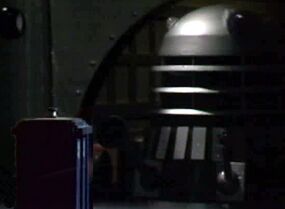
Friends and enemies could identify the TARDIS because it failed to change shape. The Daleks (DW: The Chase) even had miniature copies of the TARDIS to use as target practice (DW: Death to the Daleks). The Cybermen recognised it (DW: Earthshock), as did the Black Guardian's operative known as the Shadow. (DW: The Armageddon Factor) On occasion, by chance, an actual police box scared away a group of invading aliens from Earth when they mistook it for the Doctor's ship. (BE: Useless Things)
Captain Jack Harkness was on the look-out for "a version of" the police box throughout the 20th and early 21st centuries. (DW: Utopia) Members of LINDA also knew of the outer shape of the Doctor's TARDIS, as well as the Abzorbaloff. (DW: Love & Monsters)
Because the police box shape was relatively easily recognised, the Doctor made several attempts to change the exterior of the TARDIS. None were particularly successful.
- These attempts are chronicled at chameleon circuit.
Door
Generally, the TARDIS had two doors along one of the craft's four sides. They could open inward and outward. The right-hand door had a lock. On the left-hand door was a panel, in which was a replica of a phone used in real police boxes to summon the police. A sign on this small door offered instructions on how to use the phone. On most occasions, the left-hand door was set to a fixed position. Likewise, the windows on the door were most often seen in a closed position.
There were exceptions to all these statements.
- The Second Doctor once effected entry through the top of the TARDIS, by lifting a panel on which the roof lamp rested. (TVC: Peril at 60 Fathoms) He also attempted to enter through the back panels, the occasional cat flaps and once through the central beacon. It was indicated that these would usually work, but did not in this case. (PDA: Heart of TARDIS)
- The lock was sometimes on the left-hand door, even though normal entry was still through the right. (DW: most serials prior to The War Machines)
- The left-hand door was sometimes used for egress and the right-hand one stayed in a fixed position.
- Sometimes, both doors could be pushed open. (DW: Rose, Father's Day) or pulled (DW: The Runaway Bride, The Beast Below)
- The windows on the doors and around the exterior could be opened, at least when the First Doctor was flying the ship. (DW: "World's End", "Desperate Measures", "The Centre")
- The emergency phone was sometimes on the right-hand panel while the Second Doctor inhabited the TARDIS, but by the time of his adventure on Dulkis, it had returned to the left-hand door. (DW: The Dominators)
- During the Doctor's first incarnation, a faded St Johns Ambulance logo could be seen on the door, even though sometimes it was only barely visible under a layer of paint. During his second incarnation, it was not present. (DW: The Dominators onwards) When the TARDIS regenerated itself at the start of his eleventh incarnation, a new St John sticker appeared on the door. (DW: The Eleventh Hour)
- The exact wording on the sign on the telephone door was slightly variable over time — once it, and the writing otherwise on the front of the TARDIS, was changed to read BAD WOLF. (DW: Turn Left) When the TARDIS "regenerated" consequent to the Tenth Doctor's regeneration, this sign became backlit. (DW: The Eleventh Hour onwards)
- By the time he was going to have the chameleon circuit repaired by the Logopolitans, the Fourth Doctor had installed a handle on the telephone panel on the left-hand door. This remained a subtle, if functional, part of the design. (DW: The Empty Child)
- At some point prior to arriving to his unexpected death in San Francisco, the Seventh Doctor affixed a small handle to the right-hand door. (DW: Doctor Who) This handle persisted after the "regeneration" of the TARDIS consequent to the arrival of the Eleventh Doctor. (DW: Rose onwards)
Lock and key
Operation
Entry to the Doctor's TARDIS was usually effected by inserting a key into a lock, just as would be expected with a real police box. However, the lock did not respond to police-issued keys. (DW: Black Orchid, Blink)
Originally, Susan suggested that the key forced the user to precisely insert the key or the lock would self-destruct. (DW: "The Survivors"). Later, the key was isomorphic (DW: Spearhead from Space). Future usage of the key by several people other than the Doctor or those to whom he had given the key legitimately suggested that this isomorphic property no longer worked. It could be opened with the correct Gallifreyan key for its outdated model. (DW: The Invasion of Time)
Design and features
The external design of the key changed over time. It usually appeared to be an ordinary Yale lock key. (DW: Spearhead from Space, Rose, et al) However, it occasionally appeared to have a more ornate, Gallifreyan motif. (DW: Planet of the Spiders, Ghost Light, Doctor Who)
The key could be modified to track and locate the TARDIS, allowing the Doctor to find the TARDIS if it was within a hundred years of his position. (IDW: The Forgotten) The key was known to express a link to the TARDIS by glowing or becoming hot to the touch. (DW: Father's Day, The Eleventh Hour)
At one point, the Tenth Doctor installed a system that allowed him to lock the TARDIS remotely using a fob (as a joke, the TARDIS roof light flashed and an alarm chirp was heard, similar to that used on vehicles on Earth). He was also able to open the door remotely. (DW: The End of Time) He also discovered with the help of River Song after their adventure in The Library, that the door would open when he snapped his fingers (DW: Forest of the Dead, Day of the Moon), although this function would not be used consistently until the Eleventh Doctor's tenure.
Interior configuration and appearance
Periodically, the TARDIS interior went through metamorphoses, sometimes through choice or because of other reasons, such as the Doctor's own regeneration. (MA: Invasion of the Cat-People, DW: The Eleventh Hour)
Some of these changes were physical in nature (involving secondary control rooms, etc.), but it was also possible to re-arrange the interior design of the TARDIS with ease, using the Architectural Configuration system. (DW: Logopolis, Castrovalva, DWAN: 2006 Doctor Who Annual, BFA: Relative Dimensions ) The Fifth Doctor also called this changing "the desktop theme" (DW: Time Crash) and the TARDIS actively archived disused (and yet-to-be-used) control room configurations (DW: The Doctor's Wife). The TARDIS was capable of doing this using a variation of the chameleon circuit. (REF: Doctor Who: The Visual Dictionary)
Roundels
The TARDIS interior walls generally consisted of roundels — circular or hexagonal indentations that lined the TARDIS console room's interior walls and sometimes the walls deeper in the ship's interior. Some roundels concealed TARDIS circuitry and devices. (DW: The Wheel in Space, Death to the Daleks, Logopolis, Castrovalva, Arc of Infinity, Terminus, Vengeance on Varos, DWM: Kane's Story) At least one was a scanner. (DW: The Claws of Axos, The Beast Below)
Mass
The Doctor's TARDIS was said by Romana II to weigh 50,000 tonnes in Alzarius's gravity (DW: Full Circle), but presumably this was a measure of internal weight since the TARDIS was easily carried by Mongols and Greeks using horses and carts (DW: Marco Polo and DW: The Myth Makers) and by the Marshmen. A quarter of this mass was jettisoned for the TARDIS to escape Event One. (DW: Castrovalva) One time, when the TARDIS mapped its exterior dimensions onto its interior ones- making it the same size inside as outside- it was even larger than Gallifrey, but given that it had been infected by the Faction Paradox biodata virus at this time, this may have had an impact on its interior configuration (EDA: The Ancestor Cell).
Control room
The control or console room of the Doctor's TARDIS was the space in which the main operation of the craft was effected. It was dominated by a large, hexagonal console, typically in or near the middle of the room. Such rooms also had a scanner for viewing the outside, and immediate access to the exterior ship through a set of doors. According to one source, the trip from the console room to the outside required the passenger to step through the real world interface at the heart of the outer plasmic shell. (DW: Logopolis) Many other accounts demonstrated that the doors were just doors, though the TARDIS was cocooned in a breathable atmosphere. (DW: The Runaway Bride, The Stolen Earth, The Beast Below, Meanwhile in the TARDIS)
There were many variants of the Doctor's control room. Indeed the Doctor's TARDIS had more than one control room.
- For more details, please see control room.
Other rooms
Library
There was a library inside the TARDIS. (EDA: War of the Daleks, NA: All-Consuming Fire, NA: The Dimension Riders) Known books included Jane's Spaceships (EDA: War of the Daleks), Every Gallifreyan Child's Pop-Up Book of Nasty Creatures From Other Dimensions (NA: All-Consuming Fire), The Time Machine by H. G. Wells (DW: Doctor Who), Robinson Crusoe, (PDA: Heart of TARDIS) The Murder of Roger Ackroyd by Agatha Christie (first printing, signed, with last page missing), War and Peace, The Wonderful Wizard of Oz and The I-Spy Book of British Birds. (BFA: Storm Warning) The console room also incorporated a library at the end of the Seventh Doctor's life and the beginning of the Eighth Doctor's. (DW: Doctor Who) By the time the Eleventh Doctor was recovering from regeneration after-effects, the books in the library were ruined when the pool had fallen into it after crash-landing. (DW: The Eleventh Hour) However, it can be assumed that the TARDIS repaired the library and the Doctor began replacing the books.
Wardrobe
The Doctor kept some of the clothes from his previous regenerations, as well as clothing for other people in the TARDIS wardrobe. (DW: Pyramids of Mars, The Androids of Tara, The Twin Dilemma, Time and the Rani, The Unquiet Dead, The Christmas Invasion, The Idiot's Lantern, Victory of the Daleks, BFA: No Place Like Home) Some of these clothes were picked up along the way, or even left behind by prior travelling companions. It contained clothing from various times and environments, to suit the time and place the TARDIS' occupant(s) found themselves. This proved useful on numerous occasions for the Doctor's companions, many of whom left on their travels without taking many clothes of their own. At least some of the clothes had pockets that were bigger on the inside, most of which were worn by the Fourth, Seventh, Tenth and Eleventh Doctors. (DW: The Runaway Bride) During The Unquiet Dead, the Ninth Doctor gave incredibly long directions as where it was located. By First Night, it had changed location to be closer to the console room as the Eleventh Doctor gave River Song shorter directions.
Cloister bell/room
The cloister room was related to the cloister bell, which sounded when disaster was imminent. (DW: Logopolis, Time Crash, The Waters of Mars, The Eleventh Hour, VG: Destiny of the Doctors) The room itself appeared to be based on a garden with benches on the sides of the room and plants decorating the pillars. The Fourth Doctor visited this room with Adric prior to his regeneration (DW: Logopolis). When the TARDIS interior went through a metamorphosis, the cloister room became a grand and gothic room with an interface with the Eye of Harmony. This would be its last known appearance. (DW: Doctor Who) When the main console room was converted into a paradox machine to maintain the effects of the paradox The Master created, the bell rang continuously. (DW: Last of the Time Lords) It rang when the TARDIS was in extreme danger with occupants in it after the matrix has been removed and a malevolent lifeforce possessed it. (DW: The Doctor's Wife)
Holding ring
The holding ring was a storage area of the TARDIS which let the Doctor preserve certain rooms. When Lucie, Susan and Alex investigated it, the ring contained the rooms of many of his former companions, preserved as they had been the last time the companion were in the TARDIS. The rooms were saved in chronological order, suggesting that Susan was indeed the Doctor's first companion. Susan later teased her grandfather, calling his habit of saving rooms overly sentimental. He suggested that the ring was one of the few ways his time-travelling life allowed him to put down roots. After Susan, Alex and Lucie departed the TARDIS for new adventures on Earth, the Doctor reconsidered the wisdom of keeping so many rooms in stasis. Insisting to himself he needed to look towards the future, he deleted all the rooms on the holding ring — "except that one". (BFA: Relative Dimensions)
Swimming pool
The TARDIS had a swimming pool which was used by Leela and were Borusa was hidden from the Sontarans. However, Leela mistakenly refered to it as "the bathroom" due to thinking the pool was a bathtub. (DW: The Invasion of Time) It was later jettisoned due to leakage, something Mel found bothersome. (DW: Paradise Towers) It was replaced some time afterward, (VG: Destiny of the Doctors) and, following the TARDIS's crash after the Doctor's tenth regeneration, the water from the swimming pool fell into the library. (DW: The Eleventh Hour) After the TARDIS fixed itself, the swimming pool had been relocated to keep the library from being ruined again, but the Doctor did not know where it was at the time. (DW: The Eleventh Hour) He later revealed he had found it when he offered to swim a few laps to give Amy and Rory some privacy. (DW: Amy's Choice) Later, to save River Song after she had jumped off a New York skyscraper, the Doctor had Amy and Rory open all the doors leading to the pool to soften River's landing in the sideways TARDIS. (DW: Day of the Moon) However, the Doctor said he got rid of it to "Give the TARDIS a bit of welly" when going outside the universe. (DW: The Doctor's Wife) No doubt, he'll replace it in case River performs anymore stunts like that.
Others
- The Zero Room - This room was unaffected by the outside world and smelt of of roses for some unexplained reason unknown even to the Doctor. It was a refuge for Time Lords undergoing difficult regenerations that held danger of failing. It was later accidently jettisoned along with other rooms in the TARDIS so it could escape from Event One and end up in the Master's next trap. (DW: Castrovalva) A new one is later constructed. (BFA: Renaissance of the Daleks)
- Many companions had their own rooms in the TARDIS, decorated to their personal tastes (DW: Meglos). However, some of the companions were given previously used rooms. Though, in the case of Turlough, it is most likely because Tegan didn't know where to find other rooms. (DW: Terminus) Some of the companions shared accommodations (DW: The Edge of Destruction) and the Doctor kept several of the rooms, including the rooms of Susan and Adric; Romana's room was jettisoned, but the Doctor later retrieved it. It was onced asked if the Doctor, himself has a room, though it went unanswered (DW: The Doctor's Wife)
- There were at least fourteen bathrooms. One had a leaky faucet for three centuries. Because he had misplaced his washers, the Doctor kept it from flooding the TARDIS by sealing it in a time loop that made the same drops of water leak out over and over again. (MA: The Well-Mannered War)
- There was a laboratory which Ace used to create her explosive Nitro-9 concoction. (NA: Cat's Cradle: Time's Crucible)
- The box-room was a storage area of the TARDIS. (DWM: Exodus)
- The TARDIS at one point also had extensive utility areas and corridors which, along with the swimming pool area, became battlegrounds during an attempted Sontaran invasion of the TARDIS. (DW: The Invasion of Time) The Doctor was under the impression it had been jettisoned until he stumbled across it during his tenth incarnation. (IDW: Tesseract)
- Mel said that the Doctor used the TARDIS Laundromat to wash his clothes. (BFA: The One Doctor)
- A food machine area was originally located near (but not in) the console room. (DW: The Edge of Destruction and others)
- There was a zoo of endangered animals, a coffee machine and a jungle-like room. (DWM: Changes)
- There was what appeared to be a cricket club and pitch deep within the bowels of the TARDIS. It is here that the freshly regenerated Fifth Doctor chose his outfit. (DW: Castrovalva, BFA: No Place Like Home)
- There was a large salon which the Doctor referred to as a "boot cupboard", much to Sarah Jane Smith's shock. When Sarah Jane said it was a bit too big to be a boot cupboard he replied, "I've seen bigger boot cupboards." (DW: The Masque of Mandragora)
- The Doctor also had an art gallery with works of art from throughout history, (DW: The Invasion of Time) having rescued them from the disasters which history stated destroyed them (BFA: Dust Breeding)
- The TARDIS had a full kitchen (BFA: Relative Dimensions) which included a refrigerator. (IDW: The Whispering Gallery) The Doctor pointed out the location of the kitchen to Captain Avery after letting him into the TARDIS as a polite gesture. (DW: The Curse of the Black Spot)
- There were several gardens and rooms with wide-open meadows. (BFA: No Place Like Home)
- There was space suitable for storing vehicles. The Doctor kept a Vespa motor scooter in storage within the TARDIS. (DW: The Idiot's Lantern) The Sixth Doctor once rented a Volkswagen and stored it in the TARDIS as well. (PDA: Instruments of Darkness)
- By his eighth incarnation the Doctor had a croquet court in the TARDIS. (BFA: Caerdroia)
- By the time of the Doctor's tenth incarnation, several rooms from years (and centuries) past still existed deep within the TARDIS, including the cathedral-like room where the Doctor once fought the Master (DW: Doctor Who), and a bedroom that had once been used by Adric. (IDW: Tesseract)
- It had a sick bay, which in the Eleventh Doctor's TARDIS was up the stairs, to the left, then left again. It apparently had medical supplies to help heal one such as Mo recover from live vivisection. (DW: Cold Blood)
- It contained a drawing room, which the Doctor claimed to be his "private study". Inside it were momentos of his and past incarnations' travels.(VG: TARDIS The items inside it changed as time went by. (VG: The Gunpowder Plot)
- There was a sun room which contained a sun lounger. (VG: TARDIS)
- There was also a green door near the drawing room, which the Doctor told Amy not to go through. (VG: TARDIS)
- When The Doctor was trying to get out of his universe, he said he was deleting the scullery room and Squash court 7 to give the TARDIS an extra boost. (DW: The Doctor's Wife) This indicated he had six other Squash courts.
Systems
Specific control systems
The Fourth Doctor claimed that the TARDIS controls were isomorphic, though this appeared to have been a ruse for the benefit of Sutekh the Destroyer. (DW: Pyramids of Mars) Indeed, various companions were able to operate the TARDIS and even fly it. (DW: Castrovalva, DW: Four to Doomsday, DW: The Visitation, DW: The Five Doctors, DW: The Parting of the Ways, DW: The Sontaran Stratagem, DW: Journey's End, DW: The Time of Angels, DW: The Lodger) The Time Lords were also able to pilot the TARDIS by remote control, usually, as the Doctor once bitterly noted, so he might take care of "some dirty work they don't want to get their lily-white hands on." (DW: Colony in Space, DW: The Brain of Morbius)
The Second Doctor once used a portable Stattenheim remote control to summon his TARDIS to him (DW: The Two Doctors). The TARDIS was also vulnerable to diversion or relocation by the Guardians, Eternals, and other immensely powerful beings such as the Keeper of Traken (DW: The Ribos Operation, DW: Enlightenment, DW: The Keeper of Traken), as well as the Silence (DW : The Big Bang )
For a brief time the Fourth Doctor installed a randomiser in the navigational subsystems, though this was eventually removed. (DW: The Armageddon Factor, DW: The Leisure Hive)
The Eleventh Doctor's console
The various systems of the Eleventh Doctor's console room were fairly well-understood. According to one account, each of the six panels controlled discrete functions. (VG: TARDIS)
- The mechanical panel contained the engine release lever, door release lever, gyroscopic stabiliser, locking down mechanism (described as a physical handbrake) and the TARDIS display dials.
- The helm panel contained the eyepiece (an alternative to visual scanners), the time rotor handbrake and the space/time throttle.
- The navigation panel contained a time and space forward/back control, directional pointer, atom accelerator (the spinning spiky ball) and the spatial location input (a computer keyboard).
- The diagnostic panel contained the inertial dampers, the cooling systems (gauges), a bunsen burner and a microphone/water dispenser.
- The communications panel contained an analogue telephone, digital com, voice recorder, analogue radio waves detector/monitor/changer and a scanner/typewriter.
- The fabrication panel contained the materialise/dematerialise function, harmonic generator, time altimeter, a fabrication dispenser (which was described as being able to produce sonic screwdrivers and other technology - which eventually housed the laser screwdriver) and a Heisenberg focusing device which was used to break Heisenberg's Uncertainty Principle. This device may also have been known as a zigzag plotter.
Temporal grace
The Fourth Doctor once said the interior of the TARDIS existed in a state of "temporal grace", meaning that weapons didn't function inside the TARDIS. [source needed] However, the system seemed to be malfunctioning by the time the Fifth Doctor was piloting the vessel. (DW: Earthshock, Arc of Infinity) Indeed, during his travels with Lucie Miller, the Eighth Doctor explained that the temporal grace system had not worked in years. (BFA: Human Resources) Later, Jack Harkness was able to discharge an energy weapon in the Ninth Doctor's TARDIS, and the Tenth Doctor and Martha had to actively dodge energy bolts that had been fired into the TARDIS. (DW: The Parting of the Ways, Human Nature) This was later revealed to be a lie on the Doctor's part to deter people from firing weapons inside the TARDIS. (DW: Let's Kill Hitler)
Emergency systems
The Doctor's TARDIS contained various emergency systems, such as the Jade Pagoda, a 'life boat' of some description, which could in theory be piloted (NA: Iceberg), but in emergencies it would lock onto the nearest (spatially and temporally) planet with a breathable atmosphere and bearable climate. (NA: Sanctuary) The TARDIS also had a system which, when the TARDIS was left adrift in space unmanned, would automatically lock onto the nearest centre of gravity. (DW: Voyage of the Damned) There were also various emergency settings established by the Doctor. One was set up by the Doctor as a way of rescuing his companions (but not the Doctor himself) if the Doctor's death seemed inevitable, transporting the TARDIS (with the companion inside) back to the companion's respective time and home. This was called Emergency Programme One (DW: Bad Wolf, Silence in the Library). Another could reunite the TARDIS with the Doctor if they were separated; however it originally required another individual to enter the TARDIS and insert an 'authorised command disk' to activate it (DW: Blink), after which it seemed to have been installed and fully integrated into the ship's systems; the TARDIS automatically commenced the emergency programme without external aid in various attempts to reach the Doctor, who had been trapped in a time-loop. (SJA: The Wedding of Sarah Jane Smith)
The TARDIS also contained a switch labelled "LTD" (standing for "Locate The Doctor"). This was used by Lucie Miller. (BFA: The Beast of Orlok)
The TARDIS was also capable of extensive self-repair, for example after suffering a hull breach or having been deposited into a core of z-neutrino energy. (DW: Voyage of the Damned, DW: Journey's End) In case of more extensive damage a complete rebuilding could take place, effectively changing the interior and exterior appearance. (DW: The Eleventh Hour) The TARDIS has an alarm system known as the cloister bell that activated in dire circumstances. (DW: Logopolis, Doctor Who, Turn Left, The Waters of Mars, The End of Time)
Another emergency program activated when the TARDIS exploded. This particular program locked the control room in a time loop to protect its occupants. (DW: The Big Bang) There was also a safety mechanism which, when TARDIS rooms were deleted, automatically relocated any living beings present in the deleted room, depositing them in the control room. (DW: The Doctor's Wife)
Defensive systems
Beyond the chameleon circuit, the TARDIS could teleport itself a short distance away from its current location if it was being attacked. The Doctor called this the Hostile Action Displacement System (HADS). (DW: The Krotons)
A related system was meant to protect the TARDIS from landing in the path of oncoming vehicles, by preventing it from landing on, for example, train tracks. This feature failed when the TARDIS landed on train tracks in Vichy France. The Second Doctor, Ben, Jamie and Polly had to physically push the TARDIS out of the railway bed before the next train came down the tracks. (CC: Resistance)
The TARDIS was at one point temporarily given a defensive shield utilising a Tribophysical waveform macro-kinetic extrapolator. (DW: The Parting of the Ways)
Offensive systems
The TARDIS later gained some offensive systems of sort; this may have been caused by its development into the Edifice. This weapon allowed the Edifice/the Doctor's TARDIS to destroy Gallifrey, although this was only accomplished by channelling all of the Edifice's energy into the weapons. (EDA: The Ancestor Cell)
Intuition circuits
Using a holographic representation of the universe connected to the TARDIS' neural net, the TARDIS was effectively able to make hunches, guesses where it needed to be. Though the TARDIS was able to guess where it was needed, it was unable to inform the Doctor of what he needed to do once he got there. (VD: ...And Eternity in an Hour)
Invisibility
Visual stabilizer
The TARDIS had the ability to become completely invisible. The first time the TARDIS turned invisible was when a spaceship fired upon it when it materialised on the dark side of the moon in the 1970s. The missile that hit the TARDIS damaged its visual stabilizer, causing it to become invisible. The Second Doctor eventually managed to fix the component. (DW: The Invasion)
Other occurrences
The Eleventh Doctor used invisibility to land his TARDIS in the Oval Office in 1969, although it is not clear whether or not use of the visual stabliser was involved. President Richard Nixon was present when the TARDIS landed in the Oval Office. He remained unaware of the TARDIS' presence until it became visible. (DW: The Impossible Astronaut) The Doctor also used invisibility to hide his TARDIS in Area 51. (DW: Day of the Moon)
The Eleventh Doctor said he rarely used this feature because it drained an enormous amount of the TARDIS' power. (DW: The Impossible Astronaut)
Other systems
- The TARDIS appeared to be able to lock onto the presence of another Time Lord, particularly the Doctor's family, even when doing so would create a temporal paradox. (DW: The Doctor's Daughter)
- The Doctor made modifications and additions from time to time. For example, at one point the TARDIS was equipped to write computer files to standard Earth CD-ROMs (DW: World War Three), and he also at one point modified the control console to accept DVDs to allow Sally Sparrow to use a specialised control disc to activate the TARDIS (DW: Blink)
- It could be put one second out of synch with time. The Tenth Doctor did this once to prevent the Master from taking it. (DW: The End of Time)
- The TARDIS had the ability to allow both the Doctor and others to understand a wide variety of languages. (DW: The Christmas Invasion) See separate article for a more in-depth discussion.
- The TARDIS had a link to the Matrix. Following the Last Great Time War, this Matrix was the only one left. (IDW: The Forgotten)
- It had stabilizers activated by blue buttons. These were first used by River Song, though it was unknown if the Eleventh Doctor previously knew about these or not. He said that they made the journey no fun. (DW: The Time of Angels)
- It had brakes, which, according to River Song, were always on, which is why the TARDIS landed with a characteristic wheezing noise. When she landed the TARDIS without the brakes on, it landed without any sound. (DW: The Time of Angels)
- It had buttons for Ketchup and Mustard. (DW: Vincent and the Doctor)
- The TARDIS had a part called the "rectifier". (DW: The Lodger)
- The TARDIS' engines automatically shut down when there were no people in the craft. (DW: The Pandorica Opens)
- The TARDIS could become invisible, but such a feature was a drain on its power reserves. (DW: The Impossible Astronaut)
- The TARDIS had 'telepathic circuits' that could transmit messages to individuals through their thoughts. (DW: The Doctor's Wife)
- The TARDIS could alter the environment within its rooms and even fast-forward time within itself (or at least create the illusion of time passing). (DW: The Doctor's Wife)
- The TARDIS could stabilise the bodies of the Gangers, simply by virtue of them entering the Control Room. (DW: The Almost People)
- The TARDIS had a voice interface which the Doctor could communicate with. It could assume the form of a known individual. (DW: Let's Kill Hitler)
- The TARDIS also had an extractor fan, which was used to get rid of gases in the control room. (DW: Let's Kill Hitler)
- The TARDIS contained a lift leading to at least three floors. (VG: TARDIS)
Personality
As TARDISes were intelligent, the Doctor's TARDIS also developed a personality. It was called "sentimental" by the Eighth Doctor (DW: Doctor Who) and "stupid" by K9 (DW: The Invasion of Time). Though intelligent, it was generally unable to communicate in words with the Doctor, relying on other means. (DW: The Edge of Destruction, The Runaway Bride) Even when the TARDIS did not take the Doctor where he wanted to go, it took him where it felt he needed to be. (DW: The Doctor's Wife) The Sixth Doctor considerd "her" to be one of his most trusted companions. (VG: Destiny of the Doctors)
The TARDIS displayed a prejudicial fear of the time-locked Jack Harkness. (DW: Utopia) It showed a similar hostility to Charley Pollard when she began to travel with the Sixth Doctor (BFA: The Condemned), apparently due to the paradoxical nature of her very existence. (BFA: Storm Warning) This resulted in the TARDIS 'refusing' to protect Charley from viruses as it had protected his previous companions. (BFA: Patient Zero)
When the Doctor's history was changed so that his third incarnation regenerated ahead of schedule, the TARDIS sensed he had been infected with the Faction Paradox biodata virus, which threatened to turn him into a member of the Faction. The TARDIS took the infection into itself, holding itself together even after being nearly torn apart in a dimensional anomaly. (EDA: The Shadows of Avalon) Had it not, the Doctor would likely have become corrupted by the Faction.
When the Tenth Doctor was attacked by Es'Cartrss, the TARDIS tried to help him in the Matrix, taking the forms of his companions and helping him regain his memories. (IDW: The Forgotten)
The Doctor responded to the TARDIS' personality by showing it great tenderness. He referred to it as his "dear old friend" on one occasion. (DW: The Deadly Assassin) The Eleventh Doctor was overtly demonstrative towards it, calling it both "dear" and "you sexy thing" shortly after its own regeneration. (DW: The Eleventh Hour) In many of his incarnations he anthropomorphized it by referring to the TARDIS as "she" or "her". Indeed, at least one account suggested that it wasn't a colloquialism: the TARDIS actually was female. (ST: The Lying Old Witch in the Wardrobe)
She also exhibited a rudimentary sense of humour on occasion, choosing to display only images of attractive female companions to Amy Pond when ordered to exhibit past companions of the Doctor, causing him to chide her for not at least including "the tin dog". (DW: Meanwhile in the TARDIS #2)
{C}The TARDIS displayed a feminine personality when her matrix was temporarily transferred into the humanoid body of Idris. While in this form, she thought Rory was "pretty" and stated that she actually chose the Doctor as a travelling companion. She also referred to the TARDIS remains in a junkyard as "her sisters," implying that all TARDISes were female. The TARDIS referred to the Doctor's previous companions as "strays" and did not know the names of Amy and Rory, dubbing them "the orangy girl" and "the pretty one". She did, however, seem to be somewhat familiar with Earth culture, once comparing the Doctor's efforts to build a working TARDIS console to "a nine-year-old trying to rebuild a motorbike in his bedroom", though she was puzzled by the Doctor's reference to fish fingers. When asked her name by the Doctor, she chose to be called Sexy because that's what he called her in private (she later introduced herself to Rory and Amy by this name); she also expressed fondness for being called "Old Girl". Just prior to Idris' body being destroyed and the TARDIS' consciousness reverting to what it was, the TARDIS shared a tearful "hello" with the Doctor and was heard to utter the words "I love you" as the shell of Idris disappeared (DW: The Doctor's Wife)
- Episode writer Neil Gaiman, writing in The Brilliant Book 2012 indicated that Idris/The TARDIS was at one point also scripted to remark that she chose to remain in the police box form not because of a broken chameleon circuit, but because the Doctor liked it. She also was to have qualified her calling Rory "pretty" and Amy as "the orangy girl" by stating she rarely remembered the names of the Doctor's companions. As neither point made it on to the screen, their place in canon is a matter of debate.
Behind the scenes
- The importance of the TARDIS to the Doctor Who franchise was recognised in late 2009 when the BBC unveiled a new version of the Doctor Who logo which entered service in 2010; the logo incorporates the initials DW formed in the familiar police box shape of the Doctor's TARDIS.
- Although the TARDIS has been a constant presence in the series since 1963, it has almost always been essentially a mode of conveyance, with the majority of stories taking place away from the vessel. There have been a few exceptions, such as DW: The Edge of Destruction and Time Crash in which the entire action of a story takes place within the TARDIS. DW: Amy's Choice also falls into this category, although given the illusionary nature of the story, much of it was filmed on locations and sets other than the actual TARDIS. DW: The Invasion of Time was the first story to give viewers an extensive tour of the bowels of the TARDIS (other than occasional glimpses of individual rooms); a more modest "tour" occurred in DW: Castrovalva. Viewers also saw new aspects of the TARDIS in the 1996 TV movie. In the comic strips, several stories have taken place almost entirely within the TARDIS, including DWM: Changes and IDW: Tesseract. In DW: The Doctor's Wife, more of the TARDIS was actively explored (albeit very similar areas) and parts of said areas were used by the antagonist to try to trap or kill the occupants; this episode marked the first time since the series had returned to television in 2005 that extensive areas beyond the control and wardrobe rooms were explored on screen.
- The Doctor's TARDIS appeared in the video game Fallout in a random encounter.
- The TARDIS has appeared in every televised Doctor Who story with the exception of Mission to the Unknown, Doctor Who and the Silurians, The Sea Devils, The Sontaran Experiment, Genesis of the Daleks and Midnight.
- The characteristic wheezing noise that the TARDIS makes is made by scraping a key against piano wire.
- The TARDIS cameos in The Legend of Dick &nd Dom, when Dick & Dom are travelling through the mists of time, the TARDIS is seen in the background.
See also
- The Doctor's TARDIS from an alternate timeline.
